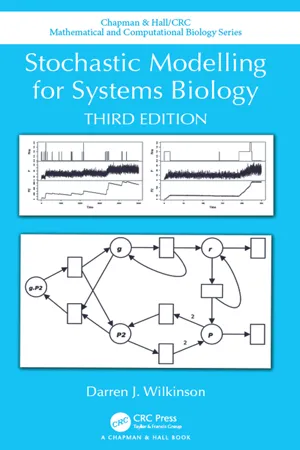
- 384 pages
- English
- ePUB (mobile friendly)
- Available on iOS & Android
Stochastic Modelling for Systems Biology, Third Edition
About this book
Since the first edition of Stochastic Modelling for Systems Biology, there have been many interesting developments in the use of "likelihood-free" methods of Bayesian inference for complex stochastic models. Having been thoroughly updated to reflect this, this third edition covers everything necessary for a good appreciation of stochastic kinetic modelling of biological networks in the systems biology context. New methods and applications are included in the book, and the use of R for practical illustration of the algorithms has been greatly extended. There is a brand new chapter on spatially extended systems, and the statistical inference chapter has also been extended with new methods, including approximate Bayesian computation (ABC). Stochastic Modelling for Systems Biology, Third Edition is now supplemented by an additional software library, written in Scala, described in a new appendix to the book.
New in the Third Edition
- New chapter on spatially extended systems, covering the spatial Gillespie algorithm for reaction diffusion master equation models in 1- and 2-d, along with fast approximations based on the spatial chemical Langevin equation
- Significantly expanded chapter on inference for stochastic kinetic models from data, covering ABC, including ABC-SMC
- Updated R package, including code relating to all of the new material
- New R package for parsing SBML models into simulatable stochastic Petri net models
- New open-source software library, written in Scala, replicating most of the functionality of the R packages in a fast, compiled, strongly typed, functional language
Keeping with the spirit of earlier editions, all of the new theory is presented in a very informal and intuitive manner, keeping the text as accessible as possible to the widest possible readership. An effective introduction to the area of stochastic modelling in computational systems biology, this new edition adds additional detail and computational methods that will provide a stronger foundation for the development of more advanced courses in stochastic biological modelling.
Frequently asked questions
- Essential is ideal for learners and professionals who enjoy exploring a wide range of subjects. Access the Essential Library with 800,000+ trusted titles and best-sellers across business, personal growth, and the humanities. Includes unlimited reading time and Standard Read Aloud voice.
- Complete: Perfect for advanced learners and researchers needing full, unrestricted access. Unlock 1.4M+ books across hundreds of subjects, including academic and specialized titles. The Complete Plan also includes advanced features like Premium Read Aloud and Research Assistant.
Please note we cannot support devices running on iOS 13 and Android 7 or earlier. Learn more about using the app.
Information
Table of contents
- Cover
- Half Title
- Title Page
- Copyright Page
- Table of Contents
- Author
- Acknowledgments
- Preface to the third edition
- Preface to the second edition
- Preface to the first edition
- I Modelling and networks
- II Stochastic processes and simulation
- III Stochastic chemical kinetics
- IV Bayesian inference
- Apppendix A SBML Models
- Apppendix B Software associated with this book
- Bibliography
- Index